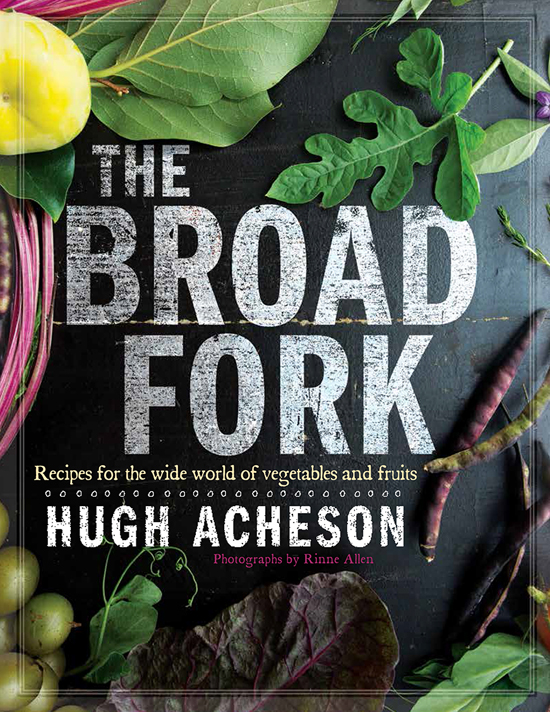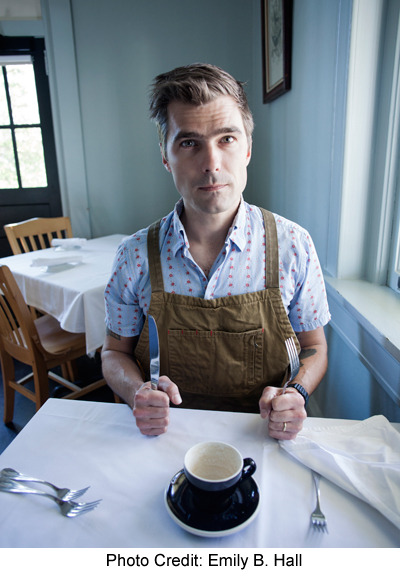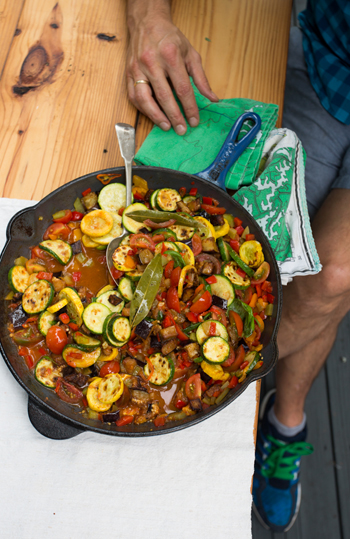Share This
Three years ago we had the pleasure of seeing Hugh Acheson in action, up close and personal, at our Oldways Supermarket Dietitian Symposium, when he conducted a food demo for our dietitian guests. This past October, while attending FNCE in Atlanta, we dined at his Empire State restaurant and were even more in awe of his creativity. (We blogged about this meal!) We all left the restaurant with signed copies of his book, Pick a Pickle, and began counting down the days until we could read and cook from his newest book, The Broad Fork: Recipes from the Wide World of Vegetables and Fruit. Although this book isn’t vegetarian it is all about making produce the star on the plate. And for those of you who know Oldways, you know this is a principle we can embrace!
Hugh has a way of romancing ingredients. Read his description of field peas and you will not only be ravenous, you may even find yourself with first-date butterflies in your belly! Throughout the book he shares personal stories that demonstrate his connection to food and community and inspires readers to learn more about ingredients. He makes vegetables approachable and introduces readers to a variety we might otherwise be intimidated to prepare. From kohlrabi to kimchi, don’t worry, Hugh has you covered!
OLDWAYS: Talk to us about your definition of a broad fork.
HUGH: More than the agricultural tool, a broad fork can be defined as an embrace of your agrarian community. It allows us to eat in a way that revisits the seasons and the abundance of vegetable and fruit variety that exists across the country.
OLDWAYS: Throughout the book, readers hear the message about the importance of connecting – with everything from local farmers to the ingredients they eat. You yourself discuss being disconnected and finding your way. Why do you think a feeling of connection is so important?
HUGH: I think that successful citizens are engaged in their community and I just happen to be lucky enough to be very involved in a community of food. To me community engagement connects the dots as to why I’m here and that we all have a common bond through food.
OLDWAYS: For those interested in becoming better members of their food community but who may not have the deep roots you have planted, can you suggest some ways for them to begin this journey?
HUGH: It is just a matter of engaging with your community as a whole. Food is something we all have in common. Go meet a farmer. Go talk to a maker. Go to the market. Converse with your bartender. Go engage with people in your neighborhood. Talk to the person who lives next to you and realize that they are from somewhere, they have troubles, beliefs, concerns, loves and interests. What are they eating?
OLDWAYS: There is often a hesitation associated with trying new things. What first steps can the timid take to help them expand their vegetable palates?
HUGH: We have to pull the blinders off of how we cook. New things should excite, not be cause for alarm. Trying new ways of cooking often takes us on a tour of the globe or of the history in our area.
OLDWAYS: In the book you talk about planning being an important part of cooking (and using all your CSA ingredients). What are some other recommendations you have for getting people to cook more often?
HUGH: Have a plan for the week. Have a plan for the box. If you don’t things go to the compost pile. Think through ideas and try something new. When life gives you cabbage, you should learn how to make kimchi.
OLDWAYS: As I mentioned, many of us at Oldways own (and love) your book, Pick a Pickle. Throughout The Broad Fork you encourage people to enjoy fermented foods. What is the easiest way to start pickling ingredients at home?
HUGH: Buy some jars and find a Saturday to hang out with the family in the kitchen. Consult the NCHFP site. Preserving, fermenting, and pickling is about teaching us ways to take a seasonal snapshot.
OLDWAYS: We can never walk away from a conversation like this without asking: Would you be so kind as to share a recipe from your book with our readers?
HUGH: Of course!
SOUTHERN RATATOUILLE
Hugh Acheson | THE BROAD FORK
I love ratatouille. It screams “summer” in all the right ways and is a great place to put pounds of your garden’s bounty. When the tomato and squash harvests are getting a little out of control, this is the best way to use them up.
Serves 6 to 8 as a side, or as a light entrée with some bread and wine
Ingredients:
1 globe eggplant
½ teaspoon ascorbic acid or freshly squeezed lemon juice
½ cup olive oil
1 large yellow summer squash, cut into ¼-inch-thick rounds
1 large zucchini, cut into ¼-inch-thick rounds
Fine sea salt
1 red bell pepper, diced
1 yellow bell pepper, diced
6 garlic cloves, minced
2 large tomatoes
1 cup chopped pickled green tomatoes or dill pickles
1 cup torn fresh basil leaves
Freshly ground black pepper
Directions:
Preheat the oven to 450°F.
Cut the eggplant into ½-inch cubes and place them in a large bowl. Cover with cold water, add the ascorbic acid, and stir well. Let it sit for 10 minutes. Then drain the eggplant and pat it dry with paper towels to blot up as much of the water as possible.
Find the largest sauté pan in your arsenal and place it over medium-high heat. Add ¼ cup of the olive oil, and when the oil is shimmery-hot, fry the eggplant, in batches, being wary of overcrowding the pan. Cook for about 2 minutes a side, until the eggplant is golden and just about cooked through. As the batches finish, use a slotted spoon to transfer the eggplant to a plate lined with paper towels. When all the eggplant is cooked, discard the oil that you just worked with and clean out the pan because we’ll be using it later.
In a mixing bowl, toss the sliced squash and zucchini with 1 tablespoon of the olive oil and fine sea salt to taste. Place them on a large baking sheet and roast in the hot oven for 5 minutes, until just tender. Remove from the oven and set aside, still on the baking sheet to cool.
Take the cleaned sauté pan and place it over medium-high heat. Add the remaining 3 tablespoons olive oil, and when the oil is hot, add the peppers to the pan. Cook for 10 minutes or until tender. Then add the garlic and cook for 2 minutes, until aromatic. Add the eggplant, squash, and zucchini. Lower the heat to medium and simmer for 5 minutes to bring the flavors together.
Cut the tomatoes in half and grate them into a bowl using a box grater. Discard the tomato skins. Pour the grated tomato into the pan of vegetables and simmer for 5 minutes. Then add the chopped pickled green tomatoes and fine sea salt to taste. Stir to combine, and finish with the torn basil leaves and black pepper to taste. Serve warm or at room temperature.




Add a Comment